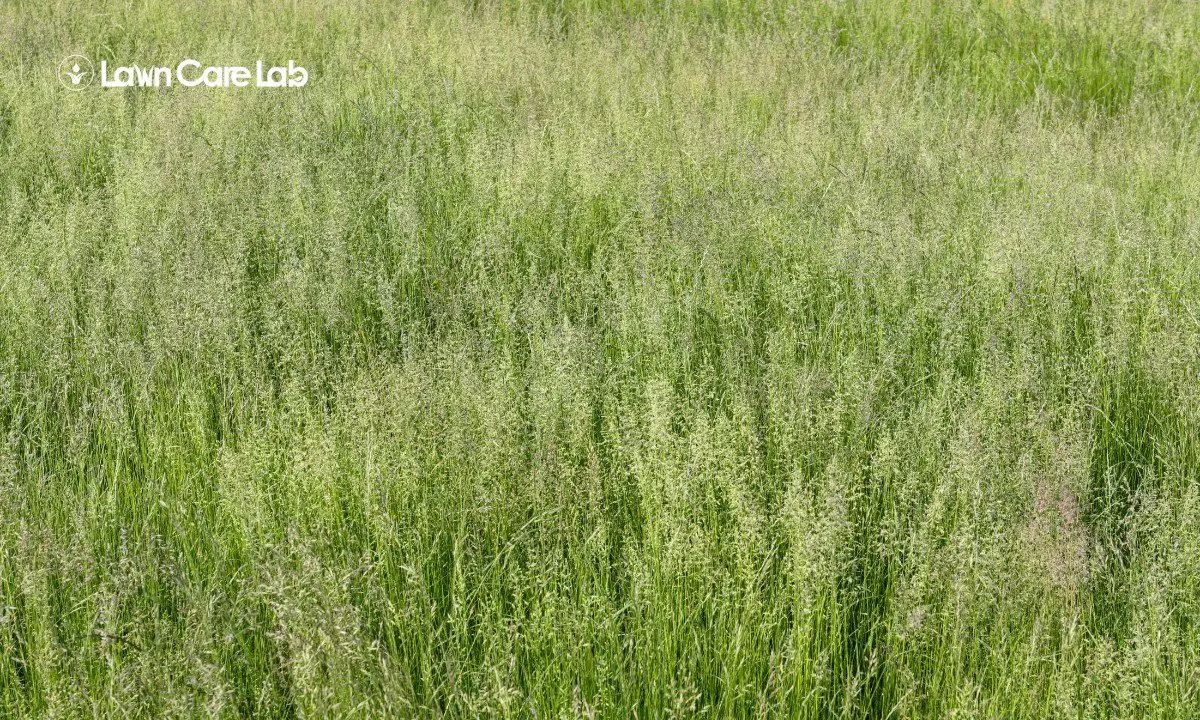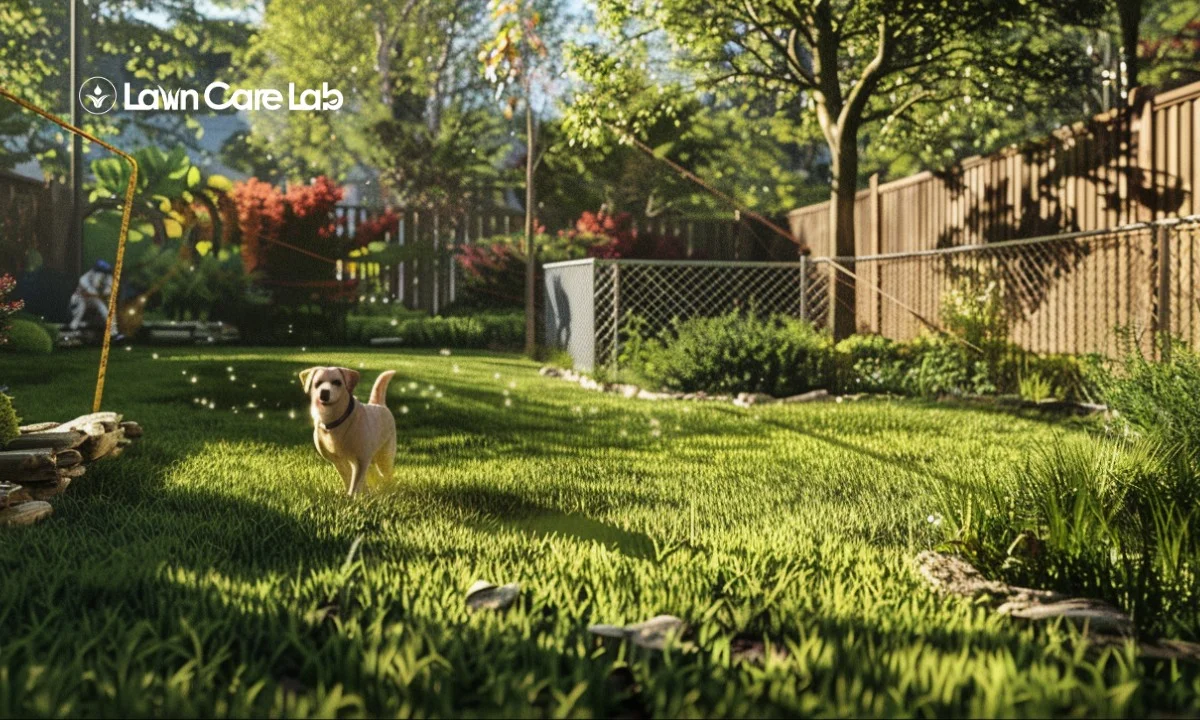Looking to upgrade your garden with lush, resilient grass? Our guide walks you through the ins and outs of growing tall fescue, a popular choice for its robust nature.
We’ll explore optimal growing conditions, top varieties, and ideal care routines and compare them with other cool-season grasses.
Let’s turn your green space into a verdant paradise with innovative gardening techniques tailored for tall fescue.
Highlights
- A consistent watering schedule is crucial for a healthy, tall fescue lawn.
- Use slow-release nitrogen-based fertilizer in early spring and late summer/early fall.
- Maintain tall fescue grass height at 3-4 inches and mow regularly.
- Tall fescue is resilient, adaptable to various soil types, and can withstand harsh weather conditions and pests.
Overview of Tall Fescue Grass
You’re probably wondering, what exactly is Tall Fescue Grass?
Well, it’s a resilient and adaptable type of grass that could be the perfect addition to your garden.
Tall Fescue Grass offers a practical and low-maintenance lawn solution with benefits like drought tolerance, resistance to disease and pests, and an ability to thrive in various soil types.
What is Tall Fescue Grass?
Tall Fescue Grass, scientifically known as Festuca arundinacea, is a robust and versatile perennial grass species notable for its deep root systems and broad leaves.
This turfgrass provides a lush, green, tall fescue lawn that can withstand various challenging conditions.
The easiest way to establish this hardy plant is through tall fescue sod or by sowing premium quality grass seed directly into prepared soil.
Benefits of Tall Fescue Grass
The turf-type tall fescue exhibits incredible durability and wear tolerance, making it a fantastic choice if you have kids or pets frequently playing on your lawn.
Its grass seed is also known for its drought tolerance, allowing your garden to retain a lush green appearance even during dry spells.
Moreover, its shade tolerance sets tall fescue seeds apart from other variants.
It thrives well in areas with partial sunlight, broadening the range of locations where you can grow it successfully.
Another advantage is its low maintenance requirement – it doesn’t demand excessive care or nutrients to flourish.
Growing Conditions for Tall Fescue
Understanding the growing conditions for Tall Fescue is crucial if you’re planning to have this resilient grass in your garden.
Specific conditions can optimize its growth, whether about climate and region adaptability, sunlight needs, or soil requirements.
Climate and Region Adaptability
Tall fescue grass is highly adaptable to various climates and regions, notably thriving in the transition zone and Pacific Northwest. When comparing Kentucky bluegrass vs. tall fescue, you’ll notice that the latter is more heat-tolerant, making it ideal for warmer areas.
Here are three key points to consider:
- Tall fescue germination time: This varies from 5-7 days, quicker than perennial ryegrass vs. tall fescue, which can take up to 14 days.
- Bermuda grass vs. tall fescue: Unlike Bermuda grass, Tall Fescue thrives in shade and can withstand various soil conditions.
- Tall Fescue vs. Kentucky Bluegrass: While both are cool-season grasses, Tall Fescue proves superior with its broader temperature adaptability.
Sunlight Needs
Despite being adaptable, this turf does best with plenty of sunshine.
Tall fescue seed head development is most vibrant under full sun exposure, although it can also tolerate light shade. So make sure to choose a location in your garden where the grass will get ample sunlight.
Comparing fine fescue vs. tall fescue, the latter is more forgiving and performs well even in less ideal conditions.
However, it still needs much sunlight to maintain its lush appearance.
The difference between ryegrass vs. tall fescue also lies in their sunlight requirements – ryegrass thrives under moderate sunlight, while tall fescue prefers stronger sun intensity.
Soil Needs
Tall fescue grass thrives in well-drained soil. It prefers a good drainage system that prevents water stagnation, promoting healthy root growth.
This grass type is also highly adaptable and shows a wide pH tolerance, meaning it can grow in acidic or basic soils.
However, maintain your garden’s pH between 5.5 to 7.5 for optimal results.
Test your soil periodically and amend it using organic matter or lime, depending on the current pH level.
Popular Tall Fescue Grass Varieties
You’re likely already familiar with Turf-Type Tall Fescue, a popular variety known for its fine texture and high tolerance to various climates.
But did you know other recommended tall fescue grass varieties might better suit your garden’s needs?
Let’s discuss them in detail so you can choose the best type for your lawn.
Turf-Type Tall Fescue
If you’re looking for a grass variety that’s resilient and easy to maintain, turf-type tall fescue might be just what your garden needs.
This cultivar is developed specifically for residential lawns, so it’s well-suited to the demands of home landscapes. Its fine blades and dark green color add beauty to any yard, while its hardiness makes it a practical choice.
- Adaptability: Turf-type tall fescue can thrive in various soil conditions.
- Drought Resistance: Unlike many grass types, this breed withstands dry periods remarkably well due to its deep root system.
- Disease Resistance: It exhibits strong resistance against common lawn diseases.
Other Recommended Varieties
Besides turf-type tall fescue, there are also other varieties you might want to consider for your lawn.
The Firecracker SLS, Rhambler 2 SRP, Falcon V, and Titane 5 are all top-notch options that can create a lush and verdant landscape.
Firecracker SLS is known for its deep green coloration and exceptional drought resistance.
Rambler 2 SRP excels in dense shading conditions.
Falcon V’s standout feature is its rapid establishment rate, perfect if you want to cover ground quickly.
On the other hand, Titane 5 offers superb disease resistance and performs well under heavy foot traffic.
Growing and Caring for Tall Fescue
From planting the seeds right, gauging the ideal watering schedule, and understanding fertilization need to mow with precision – we’ve got your back.
Planting Tall Fescue Grass
You’ll want to begin planting tall fescue grass in your garden during the fall, using methods such as seeding, sodding, or plugging for best results.
This time of year provides optimal conditions for establishing this resilient turfgrass. The cooler temperatures foster strong root development and lessen stress on new growth.
Selecting a planting method is not just about randomly picking one.
Seeding is typically the most cost-effective approach but requires careful soil preparation and watering.
Sodding offers an instant lawn but can be more costly and labor-intensive.
Plugging takes longer to establish but allows flexibility in contouring uneven terrain.
Watering Guidelines
After planting, it’s important to maintain a consistent watering schedule to ensure the health and vitality of your new lawn.
Tall fescue grass craves about 1 to 1.5 inches of water weekly, ideally distributed across several watering sessions for enhanced absorption. Overwatering can weaken the roots, while under-watering could dry up your lawn.
Consider installing an automatic irrigation system with sensors tracking rainfall and soil moisture levels for an innovative approach.
This technology enables precise and efficient watering for optimal growth.
Early morning is the best time for watering; it reduces evaporation loss and prevents fungal diseases that thrive in damp conditions overnight.
Fertilization Tips
Using the right fertilizer for Tall Fescue grass at the correct time can substantially affect your garden’s overall appearance and health.
Here are some essential tips:
- Choose a slow-release nitrogen-based fertilizer specifically designed for fescue grass.
- You’ll want to apply this initially in early spring.
- The second application should be around late summer or early fall.
- Avoid over-fertilizing as it can lead to thatch buildup and disease susceptibility.
Mowing Best Practices
Keeping your lawn at the right height is key, and it’s important to remember that mowing should be done strategically.
Don’t just chop off the tops of your tall fescue grass whenever you feel like it; instead, keep its height between 3-4 inches. This will maintain a robust root system and promote healthier growth.
Consider this simple table as a guide:
| Mow Height | Frequencies |
|---|---|
| 3 inches | Every 7-10 days |
| 4 inches | Every 11-14 days |
Your mower’s blade should always be sharp to ensure neat, clean cuts that won’t cause unnecessary stress to the grass.
Tall Fescue vs. Other Cool Season Grasses
Now that you’re familiar with growing and caring for tall fescue let’s delve into how it stacks up against other cool-season grasses.
Tall Fescue vs. Kentucky Bluegrass
When deciding between tall fescue and Kentucky bluegrass for your garden, it’s important to consider factors such as durability, appearance, and water needs.
Both types have unique aspects that make them desirable:
- Durability: Tall fescue is more resilient under stress and has superior tolerance to heat, drought, and high foot traffic compared to Kentucky bluegrass.
- Appearance: Kentucky Bluegrass has a finer texture and more vibrant color, offering a visually appealing lawn but requires more maintenance.
- Water needs: Fescue grass thrives on minimal watering, while Kentucky Bluegrass demands consistent moisture.
- Innovation aspect: Consider the innovative tall fescue varieties with improved aesthetics matching those of Kentucky bluegrass while maintaining its hardiness.
Tall Fescue vs. Perennial Ryegrass
As you ponder the idea of choosing between tall fescue and perennial ryegrass, weighing up their shade tolerance and wear resistance is crucial.
Tall fescue outshines perennial ryegrass in terms of shade tolerance. It’s a robust variety that thrives even under moderate shade, offering an innovative solution for those shady patches in your garden.
When considering wear resistance, the story shifts slightly. Perennial ryegrass takes the lead here with its sturdy nature that withstands heavy foot traffic better than tall fescue. This makes it an ideal choice for high-traffic areas or pet-filled yards.
Tall Fescue vs. Fine Fescue
Fine fescue requires less upkeep, being more drought-tolerant and shade-loving than tall fescue. It can thrive even with less water, making it an innovative choice for those seeking sustainability.
On the other hand, tall fescue is a hardy type of turfgrass that prefers cooler climates. It’s exceptional at handling foot traffic and has deep roots allowing it to consume water effectively – perfect for areas with plentiful rainfall.
When deciding between the two, consider your local climate and willingness to maintain your lawn regularly.
Both types have their merits; ultimately, the decision depends on what suits your garden best.
Conclusion
In conclusion, you’ll find that with the right care and attention, a tall fescue lawn can thrive in your garden, providing numerous benefits. This grass species is not only resilient but also aesthetically pleasing.
It’s important to note that while it may require more effort than other types of grasses like fine fescue, the results are rewarding.
For the most part, maintaining a tall fescue lawn isn’t rocket science. You must keep up with consistently mowing, watering adequately, and fertilizing wisely.
FAQs on Tall Fescue Grass
What is the ideal environment for the growth of tall fescue grass?
Can tall fescue disperse and spread independently?
Is tall fescue a perennial grass?
What is the average lifespan of tall fescue grass?
When is it optimal to plant tall fescue?
When should one mow tall fescue after seeding it?
What is the germination period for tall fescue?
Does tall fescue belong to the warm-season grass category?
How long does it take for tall fescue seeds to germinate?
- How to Create a Lawn Care Schedule for Southern Climates - October 30, 2024
- How to Use Compost Tea to Boost Lawn Growth and Soil Health - October 23, 2024
- The Best Grasses for Saltwater-Exposed Lawns: Coastal Lawn Care - October 17, 2024




